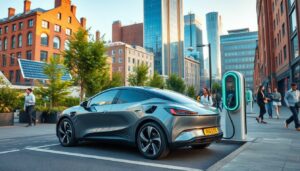Introduction
Electric vehicles (EVs) are quickly transforming transportation across the UK. More drivers are choosing electric cars over traditional petrol models. This switch helps cut pollution, reduce reliance on fossil fuels, and fight climate change.
In 2023, the UK sees a major surge in EV adoption. Governments push for cleaner air, while consumers become more aware of the benefits. Market trends show fast growth, with new infrastructure rolling out across towns and cities. It’s important for everyone to understand the latest UK EV statistics because they reveal the future of transport — whether you’re a potential buyer, a policymaker, or an industry leader.
The Current State of Electric Vehicle Adoption in the UK
Market Penetration and Growth Rates
The UK’s EV market has grown rapidly in recent years. Electric cars made up about 16% of all new vehicle registrations in 2022. That’s a big jump from just 3% in 2019. It shows how fast consumers are switching.
The number of EVs on UK roads continues to climb. By the end of 2023, over 700,000 electric vehicles are registered nationwide. The industry expects this number to double within the next three years. This rapid growth is driven by both consumer interest and government policies. Analysts project EV sales will reach 40% of all vehicle sales by 2025.
Consumer Demographics and Preferences
Who is buying these cars? Younger drivers, especially those aged 30-50, lead the way. Higher-income households tend to purchase more EVs. Geographically, London tops the charts in EV adoption, followed by the Southeast and parts of the North.
What do buyers look for? Popular models include Tesla, Nissan Leaf, and Hyundai Kona. Features like long-range batteries, quick charging, and smart tech are in demand. Government incentives, such as grants and tax breaks, also play a big role in encouraging buyers.
Policy and Regulatory Environment
The UK government supports EV adoption through various policies. They’ve set a goal to end sales of new petrol and diesel cars by 2030. Incentives like the Plug-in Car Grant reduce vehicle costs for buyers.
Low-emission zones in cities like London restrict older, more polluting vehicles. These restrictions push drivers towards cleaner options, including EVs. Future plans include expanding charging networks and subsidizing EV purchases further, which will likely boost adoption rates.
Charging Infrastructure Development and Usage Statistics
Growth of Charging Stations
The number of public charging points in the UK has grown fast in recent years. By 2023, there are over 35,000 public chargers across the country. This includes fast chargers, rapid chargers, and home charging units.
London has the most stations, with around 10,000. Other regions like the Midlands, South West, and North are catching up. Investment from both government and private firms fuels this expansion. The goal is to make charging as easy as filling up petrol, everywhere drivers go.
Charging Habits of UK EV Owners
Most EV owners charge at home. Around 80% of daily miles are topped up overnight. When they’re out, many stop at work or public stations. Average daily driving is about 25 miles, so charging needs are moderate for many.
Fast chargers are popular for longer trips or quick top-ups. Ultra-rapid chargers are becoming more common, cutting charging times down to 15-30 minutes. This makes EVs more practical for daily use and road trips.
Challenges and Opportunities in Infrastructure
Despite progress, some areas still lack enough charging stations. Rural regions and some urban neighborhoods need more coverage. Issues like high installation costs and regulatory hurdles slow expansion.
However, new tech, such as wireless charging and battery swapping, offers hope. Governments are funding projects to make infrastructure more accessible and affordable. This growth is crucial to keep up with rising EV demand.
Environmental Impact and Sustainability Data
Emissions Reduction Statistics
Switching to EVs drastically cuts emissions. Studies show EVs produce about 40% fewer CO₂ emissions than traditional cars. As the UK moves towards its climate goals, EVs help reduce the country’s overall carbon footprint.
By 2023, EV adoption prevented an estimated 10 million tons of CO₂ emissions. If the trend continues, the UK could cut its transportation emissions by almost half in the next decade.
Battery Recycling and Material Sustainability
Battery recycling is vital as EV use grows. Today, recycling programs recover over 50% of materials, such as lithium and cobalt, from used batteries. Some companies now focus on sourcing sustainable materials to lessen environmental impact.
However, challenges remain. Battery lifecycle management and sourcing eco-friendly materials are complex processes. Scaling recycling efforts is essential to prevent resource depletion and environmental harm.
Economic and Job Market Impact
The UK’s EV market fuels jobs in manufacturing, infrastructure, and maintenance. Estimates suggest over 100,000 people work directly or indirectly in the sector. As demand climbs, new factories and service centers are opening.
The industry also attracts investment, with billions pouring into EV technology and charging networks. This shift creates a positive outlook for economic growth and innovation in the UK.
Key Challenges and Opportunities for the UK EV Market
Supply Chain and Manufacturing
Global supply chains face bottlenecks, especially for batteries and chips. Shortages can slow down production. The UK is making efforts to boost local manufacturing, with plans for new EV factories and research hubs. Government support helps ease supply chain hurdles.
Consumer Awareness and Education
Many people still don’t fully understand EV benefits or costs. Confusion over charging, range, and total expenses can hold back adoption. Educating the public through campaigns and test-drive events can clear these doubts and boost confidence.
Innovation and Future Trends
Emerging tech like solid-state batteries promises longer range and faster charging. Autonomous and connected vehicles will likely become standard on UK roads in the next decade. These advances will shape the future, making electric driving more accessible, safer, and smarter.
Forecasts show EV adoption reaching 60-70% of new car sales by 2030. Expect technology breakthroughs and stricter regulations to drive this growth, transforming our roads and cities.
Conclusion
The UK electric vehicle market is growing rapidly. With over 700,000 EVs now on the roads, the trend shows no signs of slowing. Infrastructure improvements and supportive policies are key drivers of this shift.
The environmental benefits are clear — significant reductions in emissions and a step toward a greener future. Still, challenges like supply chain issues and public awareness remain. But with continued investment and innovation, the UK can lead the way in electric mobility.
To make the most of this opportunity, consumers should consider EVs for their next purchase. Policymakers must keep pushing for better infrastructure and incentives. Industry players should focus on manufacturing and tech advancements.
The road ahead is electric, and now’s the time to get involved in this exciting transformation. The future of cleaner, greener transport in the UK depends on all of us.




